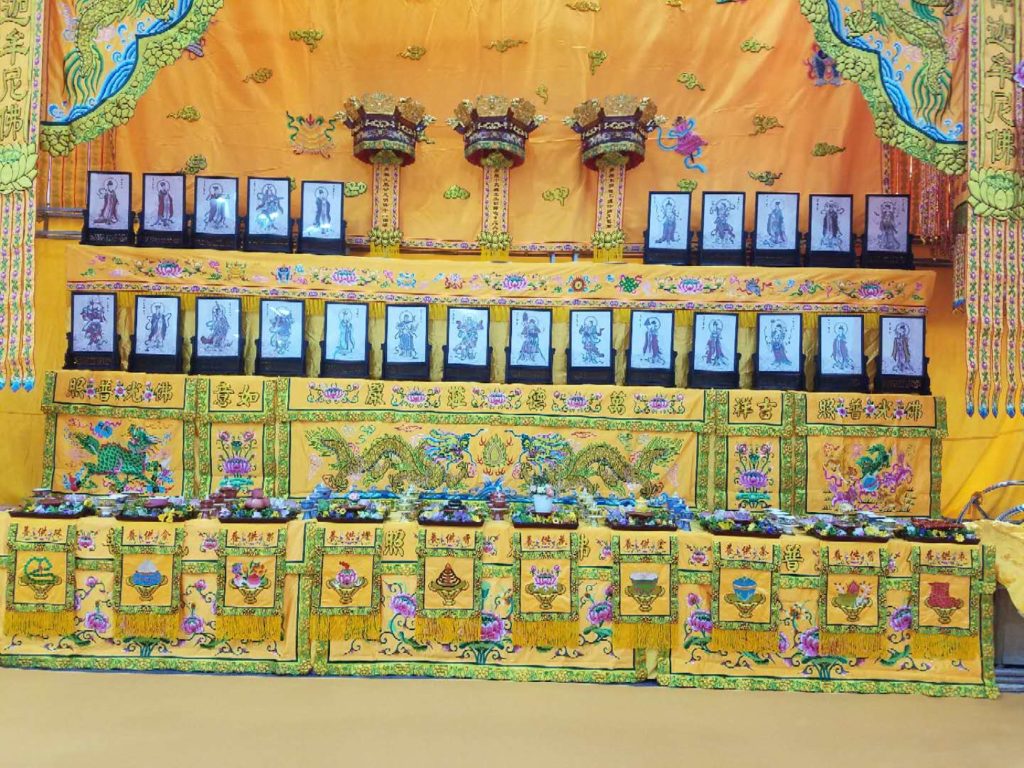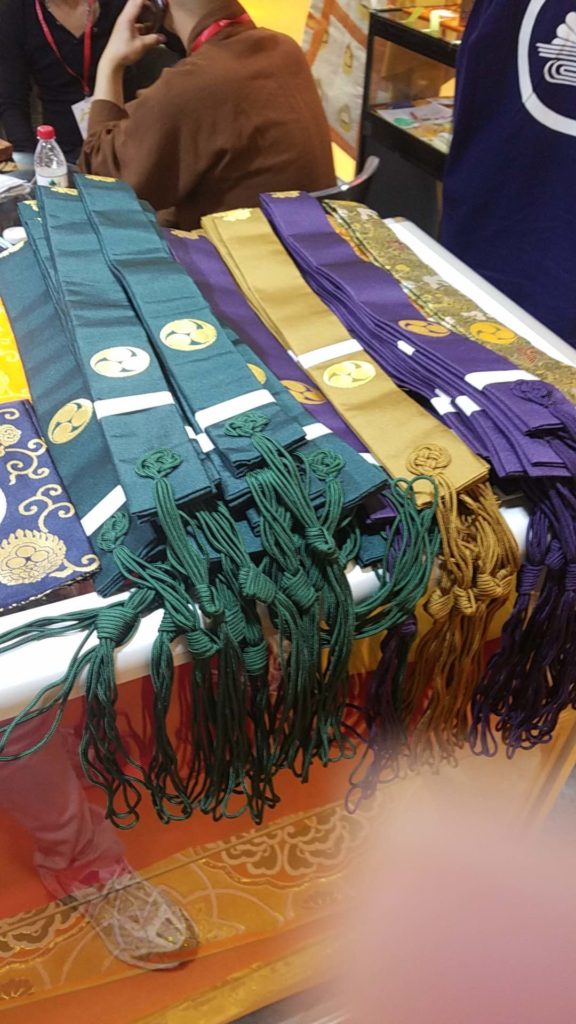I decided to get up bright and early the next day for a head-start in the expo. The hotel had run out of regular rooms, so I had been upgraded to a suite with a hot tub and ocean-view for free, so I spent my night in absolute luxury.
This time, I got to the expo, but entered through an unfamiliar entrance. Oh no, I thought to myself. This is going to be difficult.
I waded through aisles and aisles of Buddhist textiles. All sorts of tablecloths, altar cloths, streamers, banners, canopies, and every design I could possibly imagine.

I forced myself to snap out of it, and I continued walking. By the time I got to the statuary shop—only halfway to the tea expo—it was noon.
“Hey buddy!” my friend from yesterday called out. “We were just gonna have lunch, wanna join us?”
I thought about it quickly—I’d have to eat lunch anyways. Might as well eat with friends. I agreed, and we started chatting about Buddhist statues over our meal.
Halfway through lunch, Mr. Hoshino appeared from around the corner.
“I’m hungry!” he declared. “Don’t you have some food around here?”
My new friend stood up immediately, his face stricken with terror.
“Sir, are these bento boxes okay?” he asked
Mr. Hoshino inspected them.
“Eh, better than nothing,” he started eating.
Those bento boxes were supposed to be for the shop employees, but alas I guess the employees would have to wait a bit longer. My friend rushed to buy extra lunches for his staff.
“Oh!” Mr. Hoshino suddenly exclaimed. “You’re here too!”
The jerk had noticed me.
“You have time today, right?” he asked with a sleazy grin. “Why don’t you come along with me. I have a few more orders to make.”
I sighed. This time, I needed to get things done, but perhaps Mr. Hoshino could help me without knowing he was helping me.
We started walking, and as we entered a few places, he started asking about prices. During the gaps when he wasn’t asking about items he was interested in, I decided to ask about things I was interested in. I ended up with a few quotes, many business cards, and a little bit of negotiating experience.
Eventually, I was able to break free and get to the Tea Expo. Except over there, only two people talked to me.
One is the owner of a tea shop in Fuqing, not too far from Fuzhou. Another was a tea producer from Chaozhou who currently lives in Guangzhou. But as I realized, it wasn’t from interviews that I would get my information. It was on a greater scale—from observing the entire expo as a whole.
The majority of products in the Buddhist expo and the tea expo were of Japanese design. However, very few people referred to them explicitly as “Japanese” 和式. Instead, the preferred term among Chinese customers was “Tang-style” 唐式. That is, instead of purchasing Japanese items, Chinese customers understood themselves as returning to an earlier form of Chinese aesthetic (that Japanese artists had preserved).

Chinese monks are wearing Japanese robes now?
There are many, many issues with this line of thinking, as Japanese art has transformed over the centuries. To consider it as merely a regurgitation of Tang dynasty ideals is absolutely insulting. However, to those in traditional circles who are proud of Chinese heritage, it feels much easier to lay claim to this reinvented “Tang culture” than to admit that they’re actually adopting Japanese culture.
Over the course of the expo, there were shops that offered an experience in trying “Song dynasty tea whipped tea” which was using Japanese matcha… not cake tea as would have been used during the Song dynasty, there were Buddhist statues that made “Tang-style” altars (which were copied from Japanese designs), and as I mentioned earlier, there were “Tang-style floor mats” which were really just tatami.
I found it hilarious that despite Chinese tastes aligning with Japanese items, the Chinese market is unable to accept it as being labeled as Japanese, thus creating the need to relabel everything as “Tang-style.”
This points to a greater undercurrent of nationalism within the traditional arts communities here. A lot of the tea practitioners, calligraphers, and other traditional artists I’ve met here are extremely proud of Chinese culture. One person told me that Japan doesn’t have its own style of calligraphy. Everything they have is a copy of Chinese calligraphy, to which I pointed out that kana calligraphy is indeed unique to Japan. They tried to tell me that it was actually invented by the Tang dynasty monk Huaisu, and that’s when I stopped replying. There was no point.
Another egregious example is when I was told that kintsugi is a Chinese art because China had lacquer before Japan. While that is true, that doesn’t mean Chinese artisans were the first to use lacquer and gold to repair ceramics. But alas, convincing overly-prideful people that they don’t possess a monopoly on other East Asian cultures is completely useless. From this skewed perspective, everything that is good in East Asia came from China.